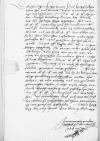List #5211
Ioannes DANTISCUS do Albrecht I von Hohenzollern-AnsbachHeilsberg (Lidzbark Warmiński), 1539-04-18
| odebrano Königsberg (Królewiec), 1539-04-19 Rękopiśmienne podstawy źródłowe:
Pomocnicze podstawy źródłowe:
Publikacje:
| ||||||||||
Tekst + aparat krytyczny + komentarzZwykły tekstTekst + komentarzTekst + aparat krytyczny
 GStA PK, HBA, C1, No 564 2 unnumbered
GStA PK, HBA, C1, No 564 2 unnumbered
Dem durchlauchten, hochgebornen fursten und hern, herrn
 GStA PK, HBA, C1, No 564 1 unnumbered
GStA PK, HBA, C1, No 564 1 unnumbered
Durchlauchter, hochgeborner furst, hochgunstiger, lÿber her und freundt. / Unser freuntliche, wÿllige dinst zuvoran. /
Aus E(wer) F(urstlichen) D(urchlauch)t cf.
Hie beÿ, wÿ uns E(wer) F(urstliche) D(urchlauch)t bericht, / das dÿ im kortzen uns etliche handlung(en) und schrÿfften wollen zcu stellen etc., seÿ wir erbottig, / und uns gern woln gebrawchen lassen / so weÿt unser slecht vorstandt reÿcht, / wÿlferig und gefellig zcu sein, / dan E(wer) F(urstliche) D(urchlauch)t, / in der gunst wir uns befelhen, / vÿl freuntlicher dinst, / und was wir sonst der selbten zu wolgefallen tzu thunn vormugen, / seÿ wir gentzlich geflÿssen. /
Datum(m)
q(ui)(?) sup(ra) ma(n)u p(ro)pria s(ub)s(cripsi)t

